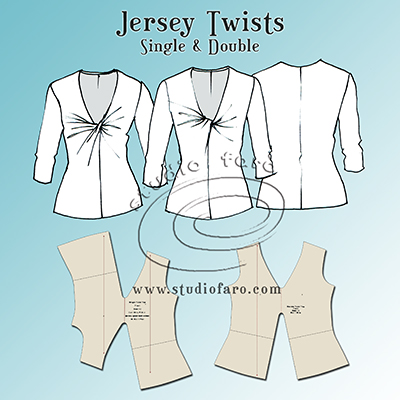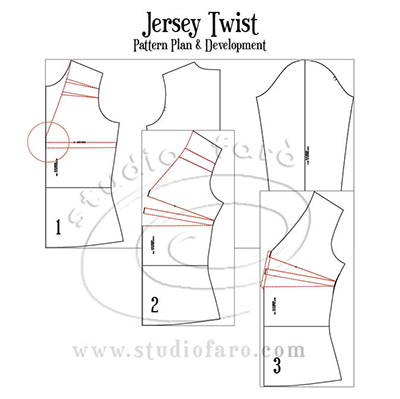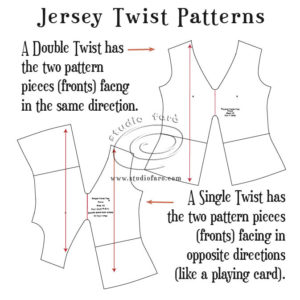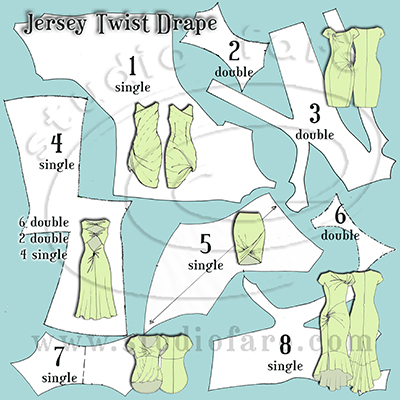05 Jan Jersey Twist Patterns
Posted at 17:27h
in Pattern Making Instructions, Pattern Puzzles, Stretch Patterns, Womens Knit Block
0 Comments
This is the first of a new series of pattern making posts called #PatternInsights, that’s me sharing the lightbulb moments of my pattern making career. Not quite as 101 as my #PatternFundamentals and nowhere near as complex as some of#PatternPuzzles, it’s another opportunity to share. 🙂 Now available as a PDF download, detailed worksheet for making Jersey Twist Patterns using My Knit Block. For just a few dollars you’ll get the same training you’d get if you came to the workshop in my studio.

My very first encounter with #TwistDrape was when I decided to turn the more challenging and enjoyable aspects of my industry patternmaking into a studio workshop. Darts to Drape in Flat Pattern Making was the first and total descriptive name for the new workshop that was soon altered to Draped Dress Patterns.
At the time I already had a number of interesting ideas where some strategic slash and spread technique and interesting dart manipulation produced lots of different kinds of drape. Some using my knit block and some using our woven skirt and dress blocks. What I would like to do here is share the very first pattern making exercise we do in our Draped Dress Patterns workshop using the Knit Block or your favourite Tee Shirt Pattern. Please note, these particular twists only work with Two-way Stretch Jersey (i.e. has some Elastane/Spandex/Lycra content).
The Single & Double Jersey Twist Top
A Twist ‘n Seam Method using a Knit Block or tee-shirt pattern:
- Trace out your front, back and sleeve side by side. Decide the location for the twist – RED CIRCLE. And add your cutting lines to introduce extra fabric in that location. Also, add a couple of Gape Darts to the neckline to bring it close to the body.
-
Cut and open the pattern along the cutting lines to introduce extra fabric. Close the Gape Darts to tighten the neckline.
-
- Add per opening:- Smaller busts – 3-4cm (1 ¼-1 ⅝”). Larger busts – 5-6cm (2-2 ⅜”)
-
- Draw a straight line across the twist area and add minimum 1cm (⅜”) to allow for the loss in your front length of the top from the twist. Curve back to the neckline and centre front line.
This is the completed pattern shape before making your final patterns. Trace a pair of this shape and follow the instructions below for the pattern pieces. Now is a good time to decide if you are making a Single or Double Twist Top.

For a Double Twist Jersey Top lay the pattern pieces facing each other and joined at the centre front. You need Cut 1 Only in two-way stretch jersey for the front with the double twist.
If you would like a Single Twist Jersey Top please ensure your fabric is good both sides. If not, you will need to self-line the front to get the right side fabric showing after the twist (i.e. Cut 1 Pair). The pattern piece is laid out like the pictures on your playing cards, i.e. the two pattern pieces with centre front together and the body parts of the pattern facing in opposite directions.

I have cut and photographed a few examples in fabric that I will share later in the week. They will show the twist in action, the order of construction and how you sew the twist seam. Patterns for the back and sleeve can be as your own preference. Do let me know if you have any questions in the comments section below.
This also presents an opportunity to pull together the #PatternPuzzles that feature similar pattern making moves for own fans and watchers. As we have moved over only a small number of our posts to this new blog, some of these links will take you back to our original blog. Enjoy 🙂

Single Twist Jersey #PatternPuzzles:
7. Twist & Turnback Top – Single twist in bodice.
1. Twist or Cowl Shift – The twist shift is a single twist.
Double Twist Jersey #PatternPuzzles:
Combination Single and Double Twists:
Let me know if you have any questions in the comments section below. Always happy to help.
Wishing you all a wonderful week. 🙂
Addendum: If you fancy making this pattern puzzle, then try my Women Knit Block as an excellent starting point. My Blocks – PDF (downloads)


No Comments